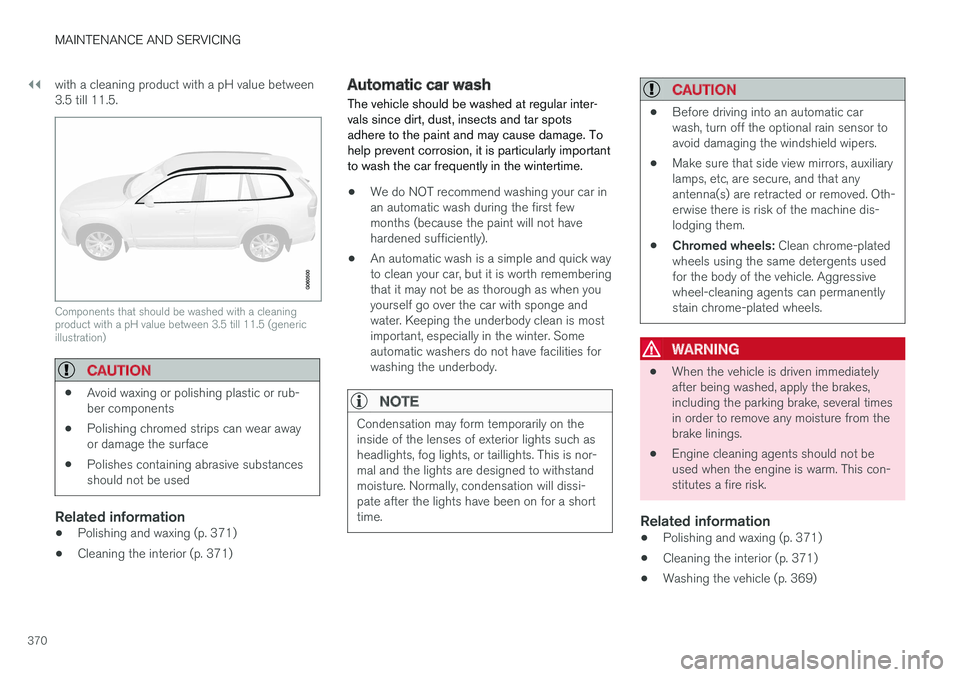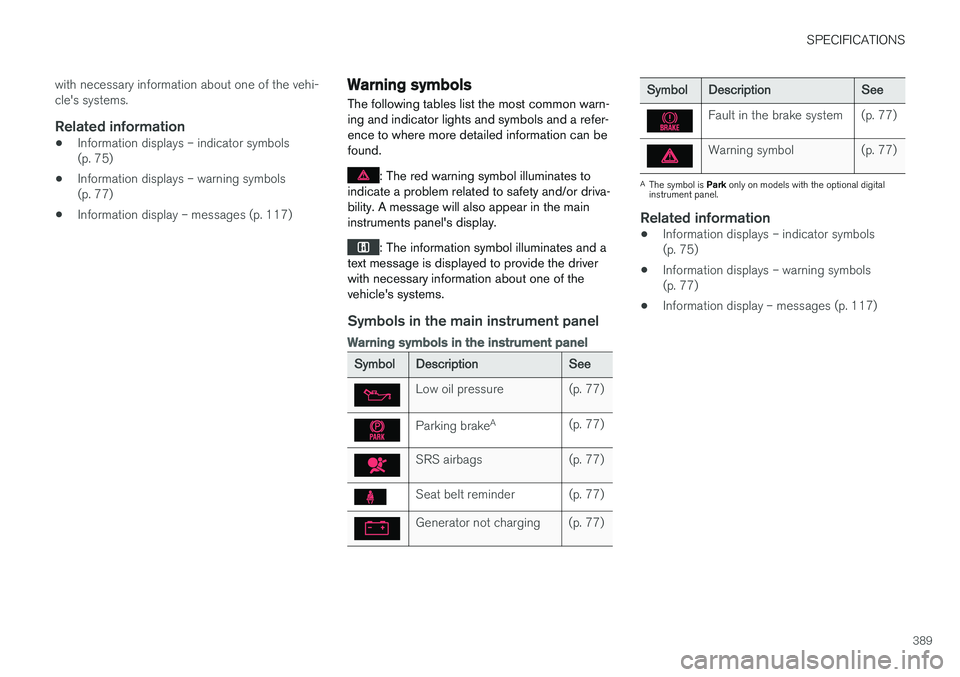Page 353 of 404
MAINTENANCE AND SERVICING
}}
* Option/accessory.351
Bulbs – specifications The following bulbs can be replaced by the vehi- cles owner. All other bulbs should only bereplaced by a trained and qualified Volvo servicetechnician.
Lighting function Wat-
tage Bulb
Low beam (halo- gen) 55 H11 LL
High beam (halo-gen) 65 H9
Extra high beam(models withActive Bending Lights *) 55 H7 LL
Front turn signals 24 PY24W License plate light- ing 5 C5W LL
Vanity mirror light-ing 1.2 W2x4.6d type
T5
Glove compart-ment lighting 5 SV8.5 (length
43mm)
Rear turn signals 21 PY21W LL
Rear fog light 21 H21W LL
Lighting function Wat-
tage Bulb
Backup light 21 H21W LL
Brake light 21 P21W LL
Cargo area lighting 5 SV8.5 (length 43mm)
Front footwell lighting 3 W2, 1x9.5d
type T10
NOTE
Please consult a Volvo retailer
Page 362 of 404
MAINTENANCE AND SERVICING
360
Fuses – engine compartment
The fuses in the engine compartment protect e.g., engine and brake functions.
Page 367 of 404
MAINTENANCE AND SERVICING
* Option/accessory.365
PosFunction A
Accelerator pedal sensor, auto- dim mirror function, heated rear seats* 7.5
-
Brake lights 5
Power moonroof
* 20
Immobilizer 5
Related information
•Fuses – engine compartment (p. 360)
• Fuses – cargo area/trunk (p. 366)
• Fuses – engine compartment cold zone (Start/Stop only) (p. 367)
Page 368 of 404
MAINTENANCE AND SERVICING
* Option/accessory.
366
Fuses – cargo area/trunk The fuses in the cargo area/trunk protect com- ponents such as trailer connections, the parkingbrake, etc.
Positions
Pos Function A
Electric parking brake (left side) 30
Electric parking brake (right side) 30
Heated rear window 30
Trailer socket 2* 15
-
Pos
Function A
12-volt socket in cargo area 15
-
-
-
-
PosFunction A
Trailer socket 1* 40
-
Related information
•Fuses – engine compartment (p. 360)
• Fuses – glove compartment (p. 363)
• Fuses – engine compartment cold zone (Start/Stop only) (p. 367)
Page 372 of 404

||
MAINTENANCE AND SERVICING
370with a cleaning product with a pH value between 3.5 till 11.5.
Components that should be washed with a cleaning product with a pH value between 3.5 till 11.5 (genericillustration)
CAUTION
•
Avoid waxing or polishing plastic or rub- ber components
• Polishing chromed strips can wear awayor damage the surface
• Polishes containing abrasive substancesshould not be used
Related information
• Polishing and waxing (p. 371)
• Cleaning the interior (p. 371)
Automatic car wash
The vehicle should be washed at regular inter- vals since dirt, dust, insects and tar spotsadhere to the paint and may cause damage. Tohelp prevent corrosion, it is particularly importantto wash the car frequently in the wintertime.
• We do NOT recommend washing your car in an automatic wash during the first fewmonths (because the paint will not havehardened sufficiently).
• An automatic wash is a simple and quick wayto clean your car, but it is worth rememberingthat it may not be as thorough as when youyourself go over the car with sponge andwater. Keeping the underbody clean is mostimportant, especially in the winter. Someautomatic washers do not have facilities forwashing the underbody.
NOTE
Condensation may form temporarily on the inside of the lenses of exterior lights such asheadlights, fog lights, or taillights. This is nor-mal and the lights are designed to withstandmoisture. Normally, condensation will dissi-pate after the lights have been on for a shorttime.
CAUTION
•
Before driving into an automatic car wash, turn off the optional rain sensor toavoid damaging the windshield wipers.
• Make sure that side view mirrors, auxiliarylamps, etc, are secure, and that anyantenna(s) are retracted or removed. Oth-erwise there is risk of the machine dis-lodging them.
• Chromed wheels:
Clean chrome-plated
wheels using the same detergents usedfor the body of the vehicle. Aggressivewheel-cleaning agents can permanentlystain chrome-plated wheels.
WARNING
• When the vehicle is driven immediately after being washed, apply the brakes,including the parking brake, several timesin order to remove any moisture from thebrake linings.
• Engine cleaning agents should not beused when the engine is warm. This con-stitutes a fire risk.
Related information
•
Polishing and waxing (p. 371)
• Cleaning the interior (p. 371)
• Washing the vehicle (p. 369)
Page 383 of 404
SPECIFICATIONS
381
Weights The following table lists important weight data for your vehicle.
CategoryUSACanada
Gross vehicle weight 4-cyl. AWD A
4980 lbs 2260 kg
Capacity weight All models: 990 lbs All models: 450 kg
Permissible axle weights, front
4-cyl. AWD 2650 lbs 1205 kg
Permissible axle weights, rear 4-cyl. AWD 2440 lbs 1105 kg
Curb weight 3870 - 3930 lbs 1760 - 1765 kg
Max. roof load 165 lbs 75 kg
Max. trailer weightsWithout brakes With brakes 1650 lbs2,000 lbs750 kg900 kg
Max. tongue weight 165 lbs 75 kg
A
All Wheel Drive
Related information
• Loading specifications (p. 312)
• Loading specifications – load limit (p. 312)
Page 387 of 404

SPECIFICATIONS
385
Coolant – specification and volume The table lists coolant volumes and specifica- tions.
SystemVolume Specification
B4204T11 8.7 US qts. (8.3 liters) Coolant with corrosion inhibi-tor mixed withwater (50/50mix), see pack-aging.
Related information
•
Engine compartment – coolant (p. 342)
Transmission oil – specification and volumes The table lists transmission oil 1
volumes and
specifications.
Automatic transmis-sion Volume
Specifica-tion
TF-80SD 7.4 US qts (7 liters) Transmis- sion fluidAW1
TG-81SC 7 US qts ( 6.6
liters)
TF-71SC 7.1 US qts (6.8 liters)
Related information
•Label information (p. 376)
Brake fluid – specification and volume
Brake fluid transfers braking force when the brake pedal is depressed to the master cylinderand to the slave cylinders on each wheel.
Specification: Volvo Original Dot 4 class 6 or
equivalent Volume: 0.63 US qts (0.6 liters)
Related information
•Engine compartment – brake fluid (p. 343)
1
Under normal driving conditions the transmission oil does not need changing during its service life. However, it may be necessary under adverse driving conditions.
Page 391 of 404

SPECIFICATIONS
389
with necessary information about one of the vehi- cle's systems.
Related information
•
Information displays – indicator symbols(p. 75)
• Information displays – warning symbols(p. 77)
• Information display – messages (p. 117)
Warning symbols
The following tables list the most common warn- ing and indicator lights and symbols and a refer-ence to where more detailed information can befound.
: The red warning symbol illuminates to
indicate a problem related to safety and/or driva- bility. A message will also appear in the maininstruments panel's display.
: The information symbol illuminates and a
text message is displayed to provide the driver with necessary information about one of thevehicle's systems.
Symbols in the main instrument panel
Warning symbols in the instrument panel
Symbol Description See
Low oil pressure (p. 77)
Parking brakeA
(p. 77)
SRS airbags (p. 77)
Seat belt reminder (p. 77)
Generator not charging (p. 77)
SymbolDescription See
Fault in the brake system (p. 77)
Warning symbol (p. 77)
A
The symbol is Park only on models with the optional digital
instrument panel.
Related information
• Information displays – indicator symbols (p. 75)
• Information displays – warning symbols(p. 77)
• Information display – messages (p. 117)